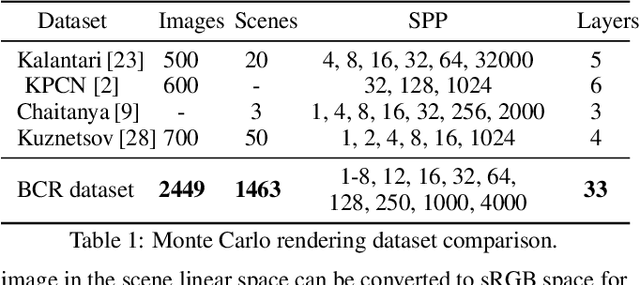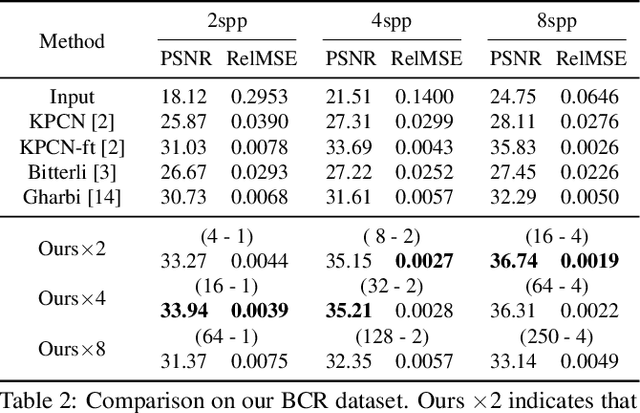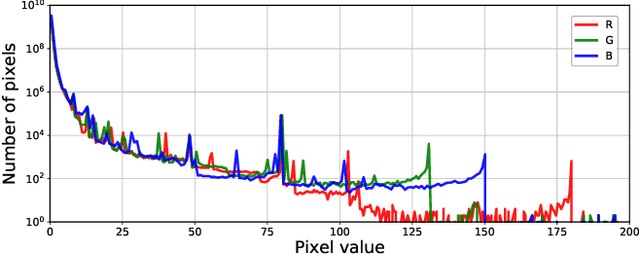Selvakumar Panneer
ContraGS: Codebook-Condensed and Trainable Gaussian Splatting for Fast, Memory-Efficient Reconstruction
Sep 03, 2025Abstract:3D Gaussian Splatting (3DGS) is a state-of-art technique to model real-world scenes with high quality and real-time rendering. Typically, a higher quality representation can be achieved by using a large number of 3D Gaussians. However, using large 3D Gaussian counts significantly increases the GPU device memory for storing model parameters. A large model thus requires powerful GPUs with high memory capacities for training and has slower training/rendering latencies due to the inefficiencies of memory access and data movement. In this work, we introduce ContraGS, a method to enable training directly on compressed 3DGS representations without reducing the Gaussian Counts, and thus with a little loss in model quality. ContraGS leverages codebooks to compactly store a set of Gaussian parameter vectors throughout the training process, thereby significantly reducing memory consumption. While codebooks have been demonstrated to be highly effective at compressing fully trained 3DGS models, directly training using codebook representations is an unsolved challenge. ContraGS solves the problem of learning non-differentiable parameters in codebook-compressed representations by posing parameter estimation as a Bayesian inference problem. To this end, ContraGS provides a framework that effectively uses MCMC sampling to sample over a posterior distribution of these compressed representations. With ContraGS, we demonstrate that ContraGS significantly reduces the peak memory during training (on average 3.49X) and accelerated training and rendering (1.36X and 1.88X on average, respectively), while retraining close to state-of-art quality.
INRet: A General Framework for Accurate Retrieval of INRs for Shapes
Jan 27, 2025



Abstract:Implicit neural representations (INRs) have become an important method for encoding various data types, such as 3D objects or scenes, images, and videos. They have proven to be particularly effective at representing 3D content, e.g., 3D scene reconstruction from 2D images, novel 3D content creation, as well as the representation, interpolation, and completion of 3D shapes. With the widespread generation of 3D data in an INR format, there is a need to support effective organization and retrieval of INRs saved in a data store. A key aspect of retrieval and clustering of INRs in a data store is the formulation of similarity between INRs that would, for example, enable retrieval of similar INRs using a query INR. In this work, we propose INRet, a method for determining similarity between INRs that represent shapes, thus enabling accurate retrieval of similar shape INRs from an INR data store. INRet flexibly supports different INR architectures such as INRs with octree grids, triplanes, and hash grids, as well as different implicit functions including signed/unsigned distance function and occupancy field. We demonstrate that our method is more general and accurate than the existing INR retrieval method, which only supports simple MLP INRs and requires the same architecture between the query and stored INRs. Furthermore, compared to converting INRs to other representations (e.g., point clouds or multi-view images) for 3D shape retrieval, INRet achieves higher accuracy while avoiding the conversion overhead.
ENVIDR: Implicit Differentiable Renderer with Neural Environment Lighting
Mar 23, 2023



Abstract:Recent advances in neural rendering have shown great potential for reconstructing scenes from multiview images. However, accurately representing objects with glossy surfaces remains a challenge for existing methods. In this work, we introduce ENVIDR, a rendering and modeling framework for high-quality rendering and reconstruction of surfaces with challenging specular reflections. To achieve this, we first propose a novel neural renderer with decomposed rendering components to learn the interaction between surface and environment lighting. This renderer is trained using existing physically based renderers and is decoupled from actual scene representations. We then propose an SDF-based neural surface model that leverages this learned neural renderer to represent general scenes. Our model additionally synthesizes indirect illuminations caused by inter-reflections from shiny surfaces by marching surface-reflected rays. We demonstrate that our method outperforms state-of-art methods on challenging shiny scenes, providing high-quality rendering of specular reflections while also enabling material editing and scene relighting.
Fast Monte Carlo Rendering via Multi-Resolution Sampling
Jun 24, 2021



Abstract:Monte Carlo rendering algorithms are widely used to produce photorealistic computer graphics images. However, these algorithms need to sample a substantial amount of rays per pixel to enable proper global illumination and thus require an immense amount of computation. In this paper, we present a hybrid rendering method to speed up Monte Carlo rendering algorithms. Our method first generates two versions of a rendering: one at a low resolution with a high sample rate (LRHS) and the other at a high resolution with a low sample rate (HRLS). We then develop a deep convolutional neural network to fuse these two renderings into a high-quality image as if it were rendered at a high resolution with a high sample rate. Specifically, we formulate this fusion task as a super resolution problem that generates a high resolution rendering from a low resolution input (LRHS), assisted with the HRLS rendering. The HRLS rendering provides critical high frequency details which are difficult to recover from the LRHS for any super resolution methods. Our experiments show that our hybrid rendering algorithm is significantly faster than the state-of-the-art Monte Carlo denoising methods while rendering high-quality images when tested on both our own BCR dataset and the Gharbi dataset. \url{https://github.com/hqqxyy/msspl}
 Add to Chrome
Add to Chrome Add to Firefox
Add to Firefox Add to Edge
Add to Edge